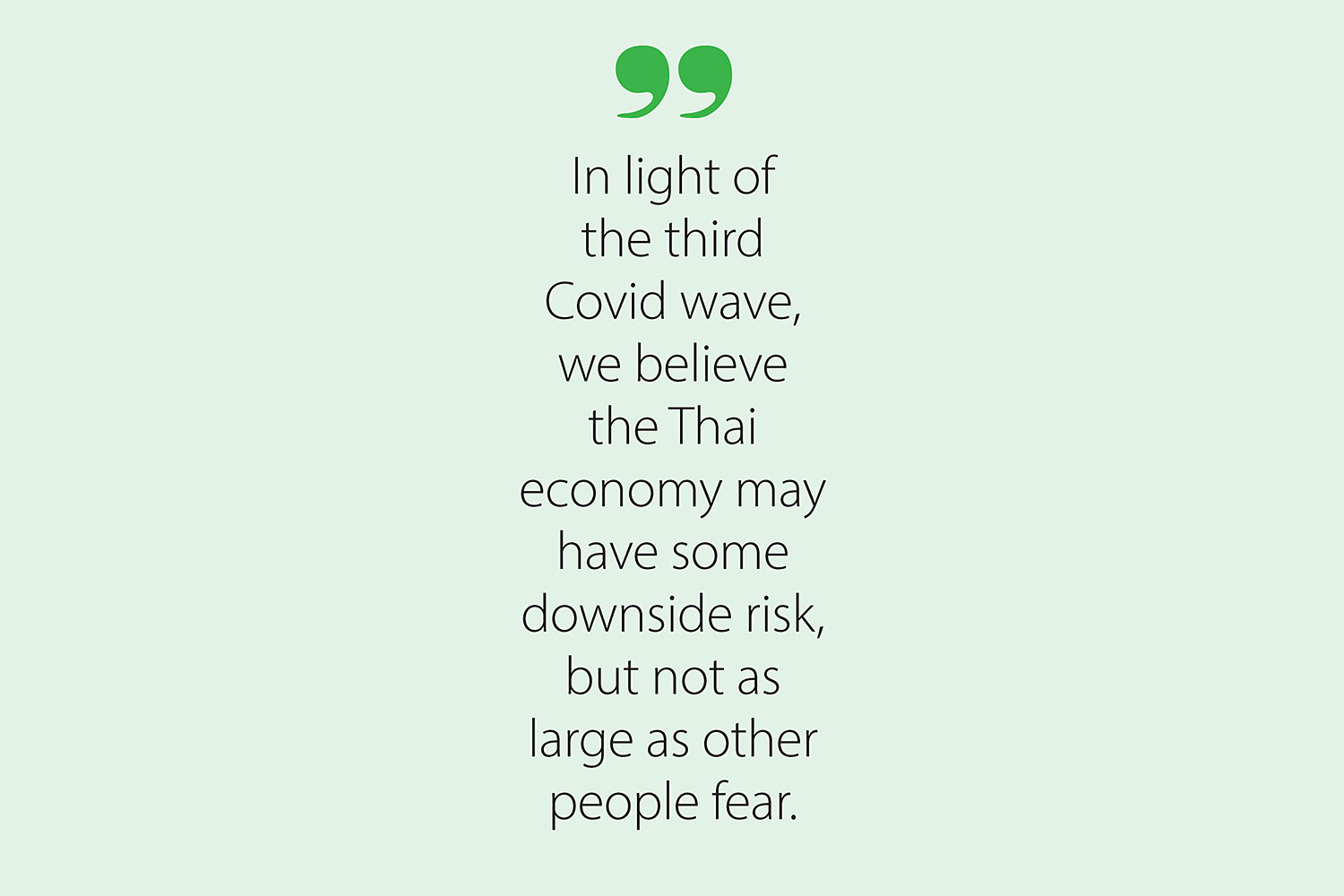Thailand: Economic outlooks diverging in second quarter
It is becoming obvious that the global economy, especially in some of the richer nations, is recovering. Recent indicators such as retail sales, industrial production, purchasing managers’ indices and labour market indicators, show good signs of revival.
Indeed, the International Monetary Fund this month revised upward its forecast for world economic expansion to 6.0% — the strongest rate in four decades — from 5.5% predicted in March.
The recovery is due mainly to three main factors: pent-up demand especially in the rich world, government and monetary stimulus measures, and the resumption of economic activity as a result of vaccinations.
The momentum is expected to build in the next few quarters. Bloomberg has calculated that Americans have at least $1.7 trillion of excess saving waiting to be put to work once the economy fully reopens and stimulus money is fully disbursed.
As well, a survey by The Economist of 21 rich countries in the first nine months of 2020 found their residents had saved a total of $6 trillion.
The signs are especially evident in countries where the highest proportion of people have been vaccinated. These include Israel, the United Arab Emirates, the United States and the United Kingdom, where vaccination rates range from 33-58%.
Nevertheless, economic outlooks have begun to diverge. While the global economy has been reviving, the prospects for emerging economies have been blighted by rising coronavirus cases. Currencies of nations stung by the virus have been underperforming those where vaccinations are surging ahead.
Monetary and fiscal policies are beginning to diverge as well. Major central banks — including the US, the euro zone and Japan — remain accommodative, as evident in the high growth of 10-25% in the money supply in those economies.
On the fiscal front, developed economies continue to stimulate activity, in particular, the United States and Europe. Washington has spent more than $4.5 trillion on fiscal stimulus to date: $2.6 trillion under the Trump administration last year and another $1.9 trillion announced in March by President Joe Biden. That doesn’t count the $2.2 trillion in infrastructure and related spending he has announced. The European Union has also approved stimulus measures worth $826 billion.
TIGHTENING IN CHINA
On the other hand, in China, leverage levels have risen significantly since last year. Total debt to GDP is now 285%, compared with 250% pre-pandemic, prompting authorities in Beijing to become more stringent.
Tighter lending rules have led to funding problems for some business sectors that were arguably facing the risk of a bubble, such as real estate. Mining and local government companies are struggling and, in some cases, starting to go bankrupt.
Here in Thailand, the most significant economic risks in the current quarter are those associated with the third Covid-19 outbreak. Notably, the number of infected people since April 1 yesterday passed 20,000, eclipsing the totals of the first month of the first and second outbreaks, at around 2,000 and 4,000 respectively. A more contagious strain, coupled with widespread travel over Songkran (the holiday was cancelled last year) have exacerbated the situation.
However, we believe the economic impact of this outbreak will not be very severe as the government has so far declined to declare a complete lockdown, focusing instead on targeted restrictions in the most high-risk “red zone” provinces.
Furthermore, the Thai public health system has gained more experience and efficiency in testing, tracking, and isolation and treatment of patients. Even if the situation worsens, the government still has 380 billion baht to further stimulate the economy, according to Dr Kulaya Tantitemit, director-general of Fiscal Policy Office.
Given those facts, we believe the economy will continue to expand by approximately 3% this year, with a downside risk of 2.8%. That is down only slightly from our pre-third wave forecast of 3.1% growth, based on healthy consumption (boosted by stimulus measures and rising farm income) and exports (due to rising global growth). But sluggish travel and tourism remains the biggest concern.
LOWER RISK
In light of the third Covid wave, we believe the Thai economy may have some downside risk, but not as large as other people fear. First, private consumption may not shrink as severely as in the first two outbreaks, given less stringent restrictions and the possibility of further stimulus measures.
The cabinet recently approved a proposal to expand the state assistance package from 31.1 million people, under the previous 210-billion-baht budget, to 33.5 million people. The proposal also extended the deadline for approved applicants to use a 7,000-baht subsidy from May 31 to June 30.
Second, we believe the spread of the virus is likely to ease in severity after April, helped by control measures and work-from-home campaigns.
Third, although the tourism outlook has deteriorated in the short term, we believe the loss of tourism revenue will be replaced by better exports resulting from the faster economic growth. Hence, we have upgraded our forecast for export growth this year from 6.2% to 10%.
Finally, we believe the economy in the first half will continue to recover slowly, but the pace will pick up in the second half when the government increase vaccinations. The success of plans to acquire an additional 35 million doses and administer them all by the end of 2021 will be crucial. If progress goes according to plan, we believe the country could see between between 3 million and 5 million foreign tourists by the end of the year.
In conclusion, although the new outbreak has hampered global and Thai economic growth, we still can pin our hopes on vaccines and the revival of international trade.
Source: https://www.bangkokpost.com/business/2104743/economic-outlooks-diverging-in-second-quarter


 Thailand
Thailand




